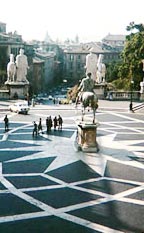 |

Home Page
Rome History
Monuments:
· Pantheon
· Colosseum
· Roman Forum
· Spanish Steps
· Trevi Fountain
· Saint Peter
· Capitoline Hill
· Castel Sant'Angelo
· Santa Maria Maggiore
· Piazza Navona
Rome Museums:
· Vatican Museums
· Capitolini Museums
· Villa Borghese
Gastronomy in Rome
Shopping in Rome
Events in Rome
Music in Rome:
· Auditorium
· S. Cecilia
· Theater of the Opera
Useful Links
:: SILVER HOTELS COLLECTION · MONUMENTS · CAPITOLINE HILL ::
![]()
 One of most famous of Rome's seven hills, Capitoline Hill is the smallest, but yet highest hill of the seven. The most noted monument seen on the hill is the site of the temples dedicated to the Capitoline Triad; the god Jupiter, his wife Juno and their daughter Minerva, whose origins date back to 590 B.C. during the reign of Tarquinius Priscus, the fifth King of Rome.
One of most famous of Rome's seven hills, Capitoline Hill is the smallest, but yet highest hill of the seven. The most noted monument seen on the hill is the site of the temples dedicated to the Capitoline Triad; the god Jupiter, his wife Juno and their daughter Minerva, whose origins date back to 590 B.C. during the reign of Tarquinius Priscus, the fifth King of Rome.
Once the center of political power, the hill has witnessed a long history of events in Rome. It survived the barbaric raids of the Celtic Gauls in 390 B.C. and it was here, in the Temple of Jupiter, that Brutus and his accomplices hid after murdering Caesar, and where one of the six Vestal Virgins, Tarpeia, the daughter of Spurious Tarpeius, betrayed Rome by letting the Sabines into the fortress with the promise of jewellery in return for the favour. Instead, after letting them in, the Sabines brutally murdered her .The rocks below the hill, appropriately named the Tarpeian Rocks after the Virgin, was the place where she was buried as well as the place where many political criminals were thrown to their death off the steep crest of the hill.
The hill was later taken by Titus Taitus, the King of the Sabines and it is here that the original Etruscan name Tarquinius was transformed into the Sabine Tarpeia.
The hill is found between the Roman Forum and Campus Martius and has two peaks, "Arx" and "Capitolium". The church of Ara Coeli was built on the Arx, during the medieval era, on the remains of a temple dedicated to Jupiter's wife Juno in 344 BC.
Also on the hill was the Tabularium, built in 79 BC and used as the empire's main archive. The hill, and the temple of Jupiter in particular were the symbols of Rome as Caput Mundi, capital of the world.
In the 16th century, between 1536 and 1546 Michelangelo began to modify the Hill designing the famous Piazza that we see today on the summit. Reversing the classical orientation of the Hill which originallyoverlooked the Forum, Michelangelo oriented the piazza to face Papal Rome.. On one side of the square is the Palazzo dei Conservatori, and on the other, the Capitoline Museum which houses exquisite collections of art. The famous "cordonata" staircase, decorated with granite statues of Egyptian lions at the foot and two large classical statues of Castor and Pollux at the top, lead to the Piazza
In the center of the square is a replica of the ancient equestrian bronze statue of Emperor Marcus Aurelius, formerly found in the Lateran Piazza and moved to the Capitoline Hill in 1538.